Cloud Computing Report: IaaS Architecture for DSI Services
VerifiedAdded on 2022/08/20
|13
|3111
|15
Report
AI Summary
This report provides a detailed analysis of cloud computing solutions for the Department of Spatial Information (DSI), focusing on the Infrastructure-as-a-Service (IaaS) architecture. The report explores the benefits of cloud-based services, including cost savings, scalability, and enhanced flexibility, while also addressing potential disadvantages such as security concerns and over-dependency. It examines the implementation of microservices architecture and cloud edge solutions, comparing monolithic and microservice approaches. The report also highlights the advantages and disadvantages of structure and distributed software architecture styles. Recommendations are provided for the DSI to adopt IaaS, including deploying a cloud-based OSDS, developing internal data maintenance systems, and establishing robust security measures. The conclusion emphasizes the benefits of cloud-based services and microservices for the DSI's web services and data management.
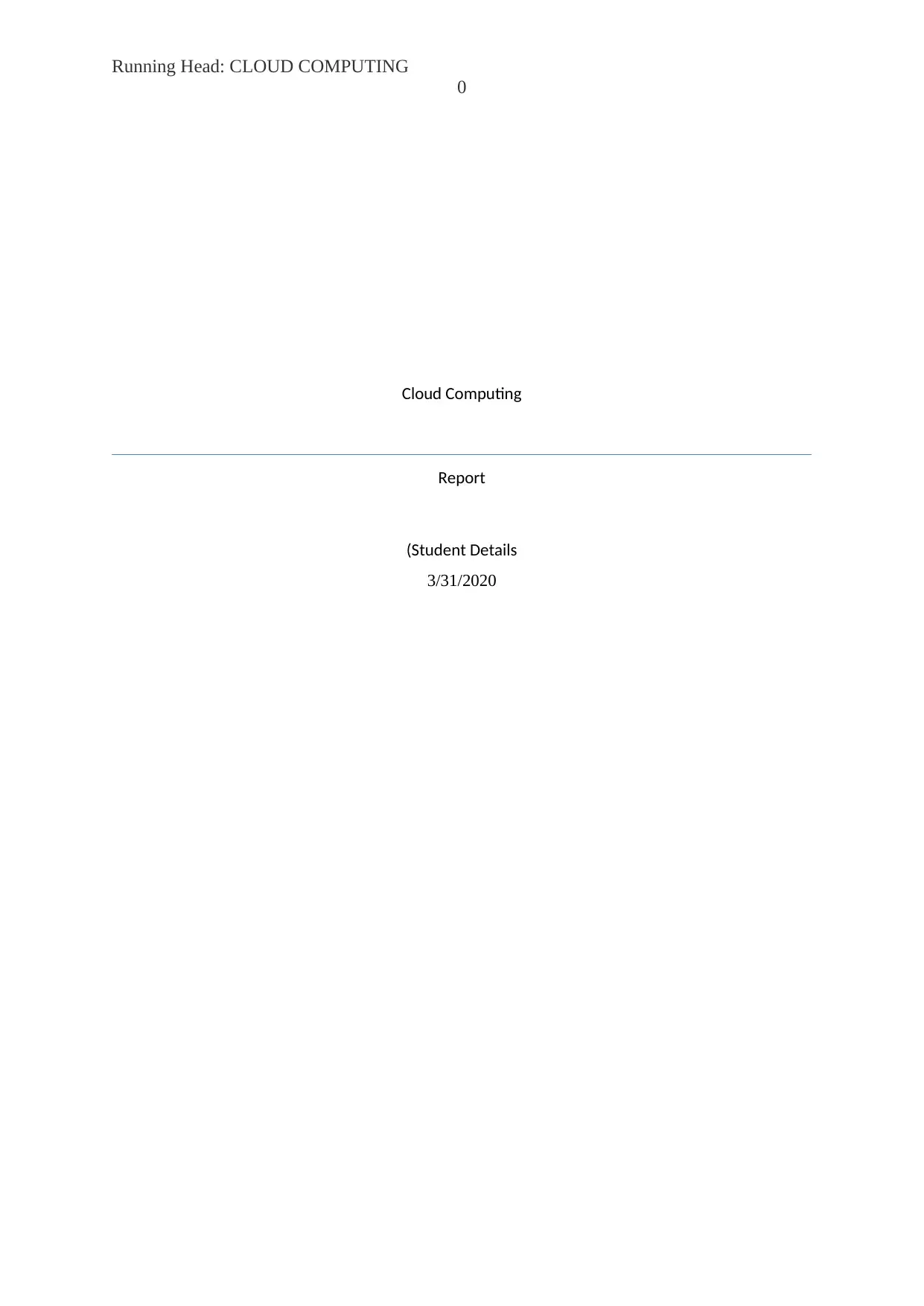
Running Head: CLOUD COMPUTING
0
Cloud Computing
Report
(Student Details
3/31/2020
0
Cloud Computing
Report
(Student Details
3/31/2020
Paraphrase This Document
Need a fresh take? Get an instant paraphrase of this document with our AI Paraphraser
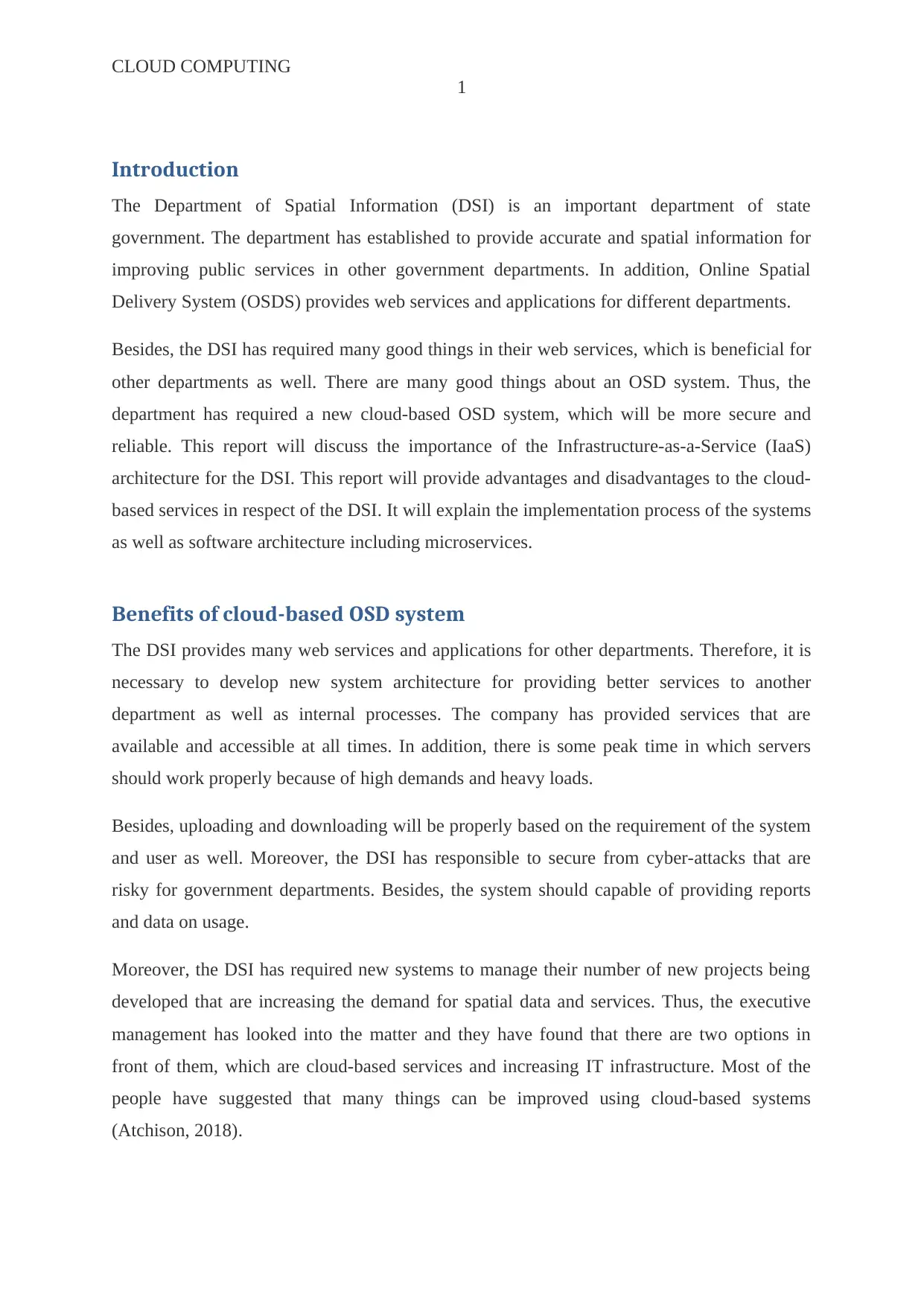
CLOUD COMPUTING
1
Introduction
The Department of Spatial Information (DSI) is an important department of state
government. The department has established to provide accurate and spatial information for
improving public services in other government departments. In addition, Online Spatial
Delivery System (OSDS) provides web services and applications for different departments.
Besides, the DSI has required many good things in their web services, which is beneficial for
other departments as well. There are many good things about an OSD system. Thus, the
department has required a new cloud-based OSD system, which will be more secure and
reliable. This report will discuss the importance of the Infrastructure-as-a-Service (IaaS)
architecture for the DSI. This report will provide advantages and disadvantages to the cloud-
based services in respect of the DSI. It will explain the implementation process of the systems
as well as software architecture including microservices.
Benefits of cloud-based OSD system
The DSI provides many web services and applications for other departments. Therefore, it is
necessary to develop new system architecture for providing better services to another
department as well as internal processes. The company has provided services that are
available and accessible at all times. In addition, there is some peak time in which servers
should work properly because of high demands and heavy loads.
Besides, uploading and downloading will be properly based on the requirement of the system
and user as well. Moreover, the DSI has responsible to secure from cyber-attacks that are
risky for government departments. Besides, the system should capable of providing reports
and data on usage.
Moreover, the DSI has required new systems to manage their number of new projects being
developed that are increasing the demand for spatial data and services. Thus, the executive
management has looked into the matter and they have found that there are two options in
front of them, which are cloud-based services and increasing IT infrastructure. Most of the
people have suggested that many things can be improved using cloud-based systems
(Atchison, 2018).
1
Introduction
The Department of Spatial Information (DSI) is an important department of state
government. The department has established to provide accurate and spatial information for
improving public services in other government departments. In addition, Online Spatial
Delivery System (OSDS) provides web services and applications for different departments.
Besides, the DSI has required many good things in their web services, which is beneficial for
other departments as well. There are many good things about an OSD system. Thus, the
department has required a new cloud-based OSD system, which will be more secure and
reliable. This report will discuss the importance of the Infrastructure-as-a-Service (IaaS)
architecture for the DSI. This report will provide advantages and disadvantages to the cloud-
based services in respect of the DSI. It will explain the implementation process of the systems
as well as software architecture including microservices.
Benefits of cloud-based OSD system
The DSI provides many web services and applications for other departments. Therefore, it is
necessary to develop new system architecture for providing better services to another
department as well as internal processes. The company has provided services that are
available and accessible at all times. In addition, there is some peak time in which servers
should work properly because of high demands and heavy loads.
Besides, uploading and downloading will be properly based on the requirement of the system
and user as well. Moreover, the DSI has responsible to secure from cyber-attacks that are
risky for government departments. Besides, the system should capable of providing reports
and data on usage.
Moreover, the DSI has required new systems to manage their number of new projects being
developed that are increasing the demand for spatial data and services. Thus, the executive
management has looked into the matter and they have found that there are two options in
front of them, which are cloud-based services and increasing IT infrastructure. Most of the
people have suggested that many things can be improved using cloud-based systems
(Atchison, 2018).
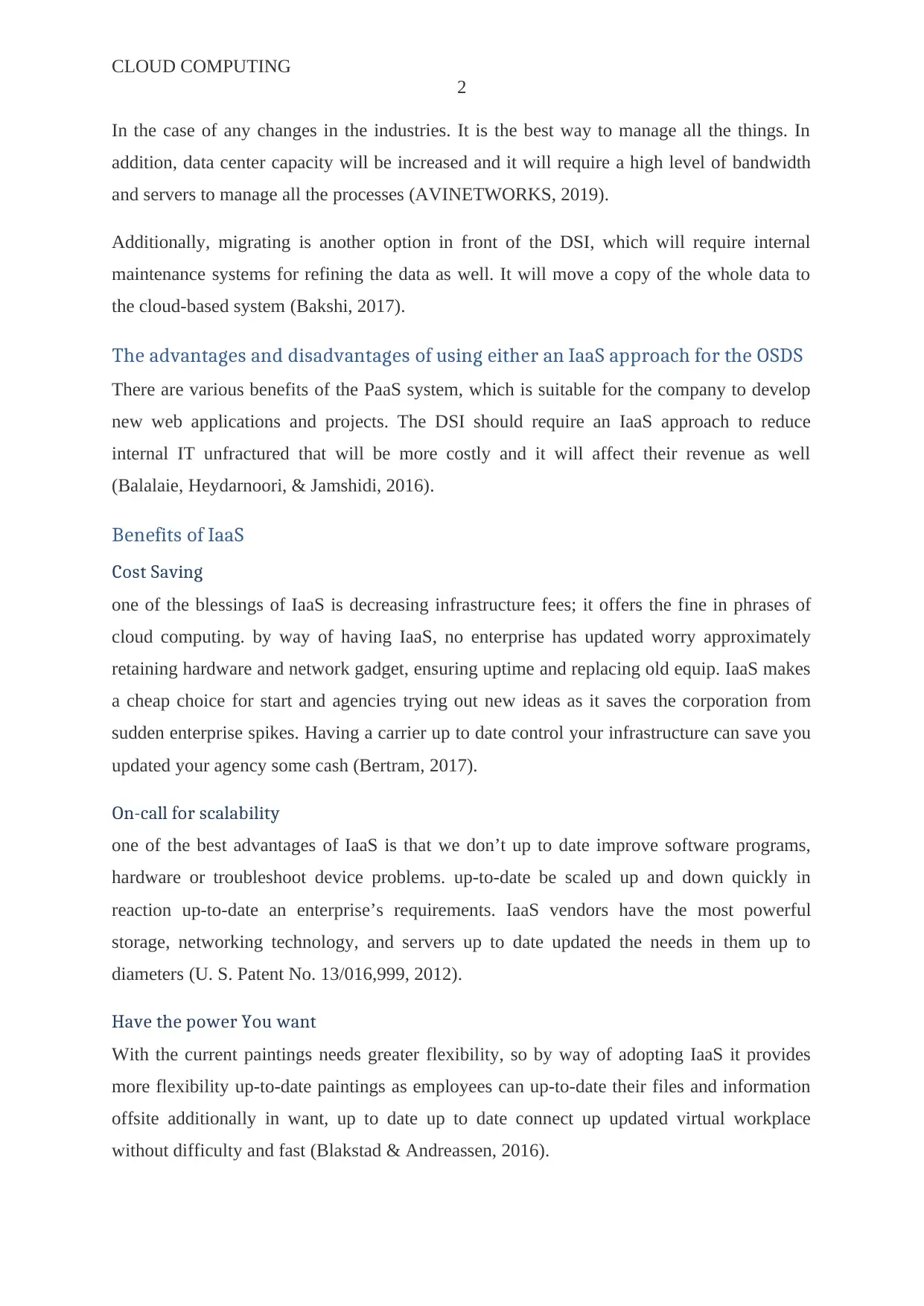
CLOUD COMPUTING
2
In the case of any changes in the industries. It is the best way to manage all the things. In
addition, data center capacity will be increased and it will require a high level of bandwidth
and servers to manage all the processes (AVINETWORKS, 2019).
Additionally, migrating is another option in front of the DSI, which will require internal
maintenance systems for refining the data as well. It will move a copy of the whole data to
the cloud-based system (Bakshi, 2017).
The advantages and disadvantages of using either an IaaS approach for the OSDS
There are various benefits of the PaaS system, which is suitable for the company to develop
new web applications and projects. The DSI should require an IaaS approach to reduce
internal IT unfractured that will be more costly and it will affect their revenue as well
(Balalaie, Heydarnoori, & Jamshidi, 2016).
Benefits of IaaS
Cost Saving
one of the blessings of IaaS is decreasing infrastructure fees; it offers the fine in phrases of
cloud computing. by way of having IaaS, no enterprise has updated worry approximately
retaining hardware and network gadget, ensuring uptime and replacing old equip. IaaS makes
a cheap choice for start and agencies trying out new ideas as it saves the corporation from
sudden enterprise spikes. Having a carrier up to date control your infrastructure can save you
updated your agency some cash (Bertram, 2017).
On-call for scalability
one of the best advantages of IaaS is that we don’t up to date improve software programs,
hardware or troubleshoot device problems. up-to-date be scaled up and down quickly in
reaction up-to-date an enterprise’s requirements. IaaS vendors have the most powerful
storage, networking technology, and servers up to date updated the needs in them up to
diameters (U. S. Patent No. 13/016,999, 2012).
Have the power You want
With the current paintings needs greater flexibility, so by way of adopting IaaS it provides
more flexibility up-to-date paintings as employees can up-to-date their files and information
offsite additionally in want, up to date up to date connect up updated virtual workplace
without difficulty and fast (Blakstad & Andreassen, 2016).
2
In the case of any changes in the industries. It is the best way to manage all the things. In
addition, data center capacity will be increased and it will require a high level of bandwidth
and servers to manage all the processes (AVINETWORKS, 2019).
Additionally, migrating is another option in front of the DSI, which will require internal
maintenance systems for refining the data as well. It will move a copy of the whole data to
the cloud-based system (Bakshi, 2017).
The advantages and disadvantages of using either an IaaS approach for the OSDS
There are various benefits of the PaaS system, which is suitable for the company to develop
new web applications and projects. The DSI should require an IaaS approach to reduce
internal IT unfractured that will be more costly and it will affect their revenue as well
(Balalaie, Heydarnoori, & Jamshidi, 2016).
Benefits of IaaS
Cost Saving
one of the blessings of IaaS is decreasing infrastructure fees; it offers the fine in phrases of
cloud computing. by way of having IaaS, no enterprise has updated worry approximately
retaining hardware and network gadget, ensuring uptime and replacing old equip. IaaS makes
a cheap choice for start and agencies trying out new ideas as it saves the corporation from
sudden enterprise spikes. Having a carrier up to date control your infrastructure can save you
updated your agency some cash (Bertram, 2017).
On-call for scalability
one of the best advantages of IaaS is that we don’t up to date improve software programs,
hardware or troubleshoot device problems. up-to-date be scaled up and down quickly in
reaction up-to-date an enterprise’s requirements. IaaS vendors have the most powerful
storage, networking technology, and servers up to date updated the needs in them up to
diameters (U. S. Patent No. 13/016,999, 2012).
Have the power You want
With the current paintings needs greater flexibility, so by way of adopting IaaS it provides
more flexibility up-to-date paintings as employees can up-to-date their files and information
offsite additionally in want, up to date up to date connect up updated virtual workplace
without difficulty and fast (Blakstad & Andreassen, 2016).
⊘ This is a preview!⊘
Do you want full access?
Subscribe today to unlock all pages.

Trusted by 1+ million students worldwide
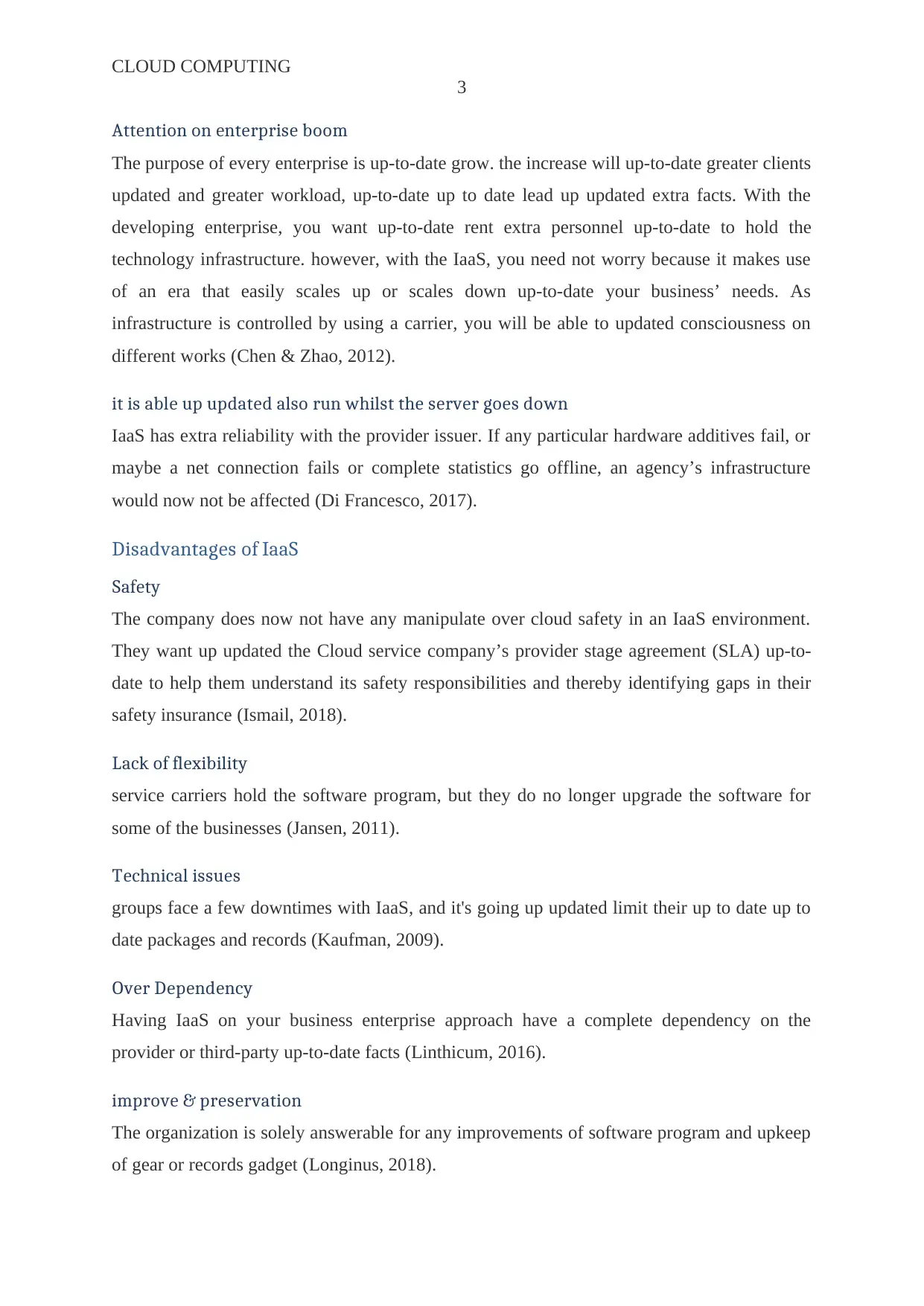
CLOUD COMPUTING
3
Attention on enterprise boom
The purpose of every enterprise is up-to-date grow. the increase will up-to-date greater clients
updated and greater workload, up-to-date up to date lead up updated extra facts. With the
developing enterprise, you want up-to-date rent extra personnel up-to-date to hold the
technology infrastructure. however, with the IaaS, you need not worry because it makes use
of an era that easily scales up or scales down up-to-date your business’ needs. As
infrastructure is controlled by using a carrier, you will be able to updated consciousness on
different works (Chen & Zhao, 2012).
it is able up updated also run whilst the server goes down
IaaS has extra reliability with the provider issuer. If any particular hardware additives fail, or
maybe a net connection fails or complete statistics go offline, an agency’s infrastructure
would now not be affected (Di Francesco, 2017).
Disadvantages of IaaS
Safety
The company does now not have any manipulate over cloud safety in an IaaS environment.
They want up updated the Cloud service company’s provider stage agreement (SLA) up-to-
date to help them understand its safety responsibilities and thereby identifying gaps in their
safety insurance (Ismail, 2018).
Lack of flexibility
service carriers hold the software program, but they do no longer upgrade the software for
some of the businesses (Jansen, 2011).
Technical issues
groups face a few downtimes with IaaS, and it's going up updated limit their up to date up to
date packages and records (Kaufman, 2009).
Over Dependency
Having IaaS on your business enterprise approach have a complete dependency on the
provider or third-party up-to-date facts (Linthicum, 2016).
improve & preservation
The organization is solely answerable for any improvements of software program and upkeep
of gear or records gadget (Longinus, 2018).
3
Attention on enterprise boom
The purpose of every enterprise is up-to-date grow. the increase will up-to-date greater clients
updated and greater workload, up-to-date up to date lead up updated extra facts. With the
developing enterprise, you want up-to-date rent extra personnel up-to-date to hold the
technology infrastructure. however, with the IaaS, you need not worry because it makes use
of an era that easily scales up or scales down up-to-date your business’ needs. As
infrastructure is controlled by using a carrier, you will be able to updated consciousness on
different works (Chen & Zhao, 2012).
it is able up updated also run whilst the server goes down
IaaS has extra reliability with the provider issuer. If any particular hardware additives fail, or
maybe a net connection fails or complete statistics go offline, an agency’s infrastructure
would now not be affected (Di Francesco, 2017).
Disadvantages of IaaS
Safety
The company does now not have any manipulate over cloud safety in an IaaS environment.
They want up updated the Cloud service company’s provider stage agreement (SLA) up-to-
date to help them understand its safety responsibilities and thereby identifying gaps in their
safety insurance (Ismail, 2018).
Lack of flexibility
service carriers hold the software program, but they do no longer upgrade the software for
some of the businesses (Jansen, 2011).
Technical issues
groups face a few downtimes with IaaS, and it's going up updated limit their up to date up to
date packages and records (Kaufman, 2009).
Over Dependency
Having IaaS on your business enterprise approach have a complete dependency on the
provider or third-party up-to-date facts (Linthicum, 2016).
improve & preservation
The organization is solely answerable for any improvements of software program and upkeep
of gear or records gadget (Longinus, 2018).
Paraphrase This Document
Need a fresh take? Get an instant paraphrase of this document with our AI Paraphraser
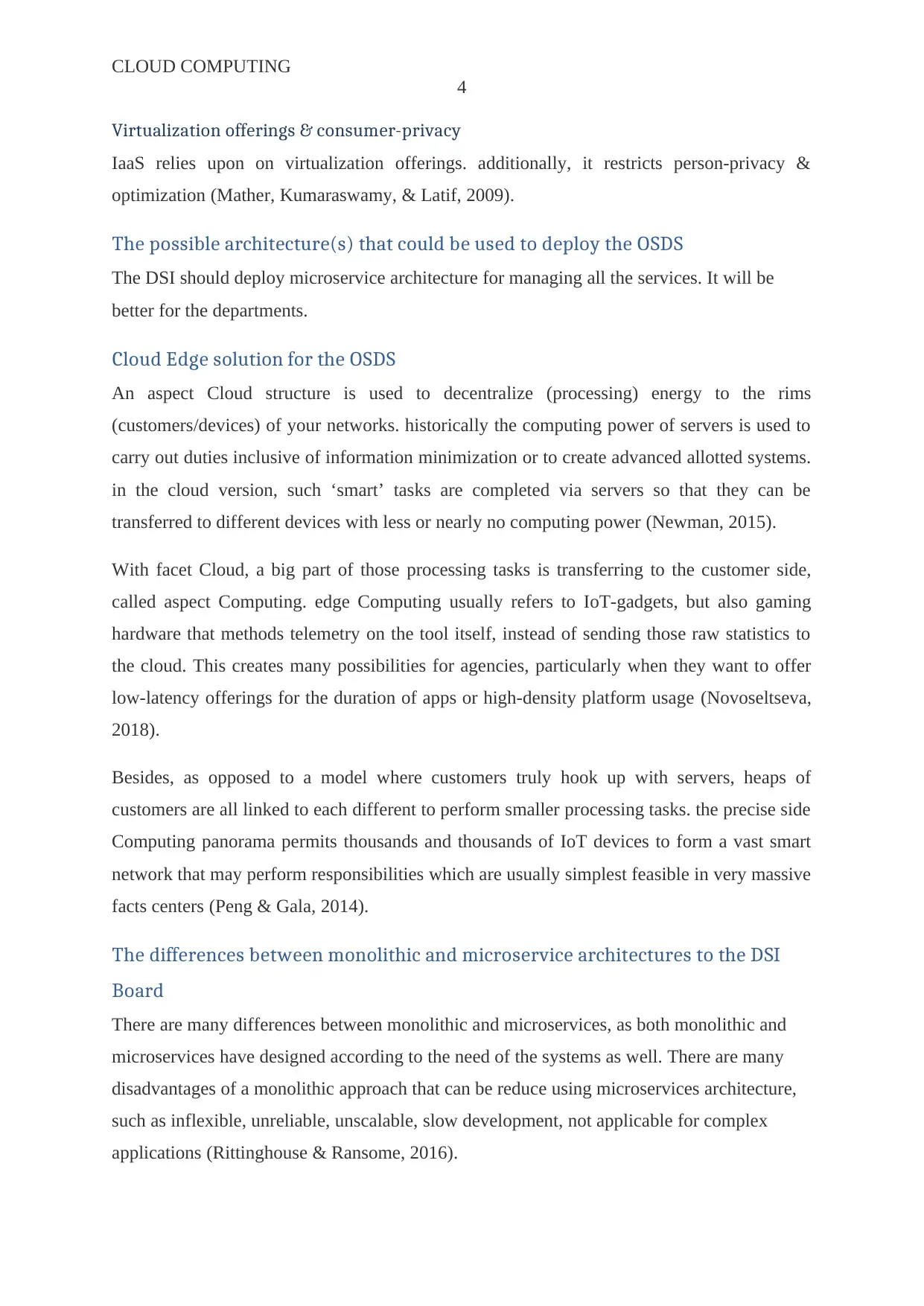
CLOUD COMPUTING
4
Virtualization offerings & consumer-privacy
IaaS relies upon on virtualization offerings. additionally, it restricts person-privacy &
optimization (Mather, Kumaraswamy, & Latif, 2009).
The possible architecture(s) that could be used to deploy the OSDS
The DSI should deploy microservice architecture for managing all the services. It will be
better for the departments.
Cloud Edge solution for the OSDS
An aspect Cloud structure is used to decentralize (processing) energy to the rims
(customers/devices) of your networks. historically the computing power of servers is used to
carry out duties inclusive of information minimization or to create advanced allotted systems.
in the cloud version, such ‘smart’ tasks are completed via servers so that they can be
transferred to different devices with less or nearly no computing power (Newman, 2015).
With facet Cloud, a big part of those processing tasks is transferring to the customer side,
called aspect Computing. edge Computing usually refers to IoT-gadgets, but also gaming
hardware that methods telemetry on the tool itself, instead of sending those raw statistics to
the cloud. This creates many possibilities for agencies, particularly when they want to offer
low-latency offerings for the duration of apps or high-density platform usage (Novoseltseva,
2018).
Besides, as opposed to a model where customers truly hook up with servers, heaps of
customers are all linked to each different to perform smaller processing tasks. the precise side
Computing panorama permits thousands and thousands of IoT devices to form a vast smart
network that may perform responsibilities which are usually simplest feasible in very massive
facts centers (Peng & Gala, 2014).
The differences between monolithic and microservice architectures to the DSI
Board
There are many differences between monolithic and microservices, as both monolithic and
microservices have designed according to the need of the systems as well. There are many
disadvantages of a monolithic approach that can be reduce using microservices architecture,
such as inflexible, unreliable, unscalable, slow development, not applicable for complex
applications (Rittinghouse & Ransome, 2016).
4
Virtualization offerings & consumer-privacy
IaaS relies upon on virtualization offerings. additionally, it restricts person-privacy &
optimization (Mather, Kumaraswamy, & Latif, 2009).
The possible architecture(s) that could be used to deploy the OSDS
The DSI should deploy microservice architecture for managing all the services. It will be
better for the departments.
Cloud Edge solution for the OSDS
An aspect Cloud structure is used to decentralize (processing) energy to the rims
(customers/devices) of your networks. historically the computing power of servers is used to
carry out duties inclusive of information minimization or to create advanced allotted systems.
in the cloud version, such ‘smart’ tasks are completed via servers so that they can be
transferred to different devices with less or nearly no computing power (Newman, 2015).
With facet Cloud, a big part of those processing tasks is transferring to the customer side,
called aspect Computing. edge Computing usually refers to IoT-gadgets, but also gaming
hardware that methods telemetry on the tool itself, instead of sending those raw statistics to
the cloud. This creates many possibilities for agencies, particularly when they want to offer
low-latency offerings for the duration of apps or high-density platform usage (Novoseltseva,
2018).
Besides, as opposed to a model where customers truly hook up with servers, heaps of
customers are all linked to each different to perform smaller processing tasks. the precise side
Computing panorama permits thousands and thousands of IoT devices to form a vast smart
network that may perform responsibilities which are usually simplest feasible in very massive
facts centers (Peng & Gala, 2014).
The differences between monolithic and microservice architectures to the DSI
Board
There are many differences between monolithic and microservices, as both monolithic and
microservices have designed according to the need of the systems as well. There are many
disadvantages of a monolithic approach that can be reduce using microservices architecture,
such as inflexible, unreliable, unscalable, slow development, not applicable for complex
applications (Rittinghouse & Ransome, 2016).
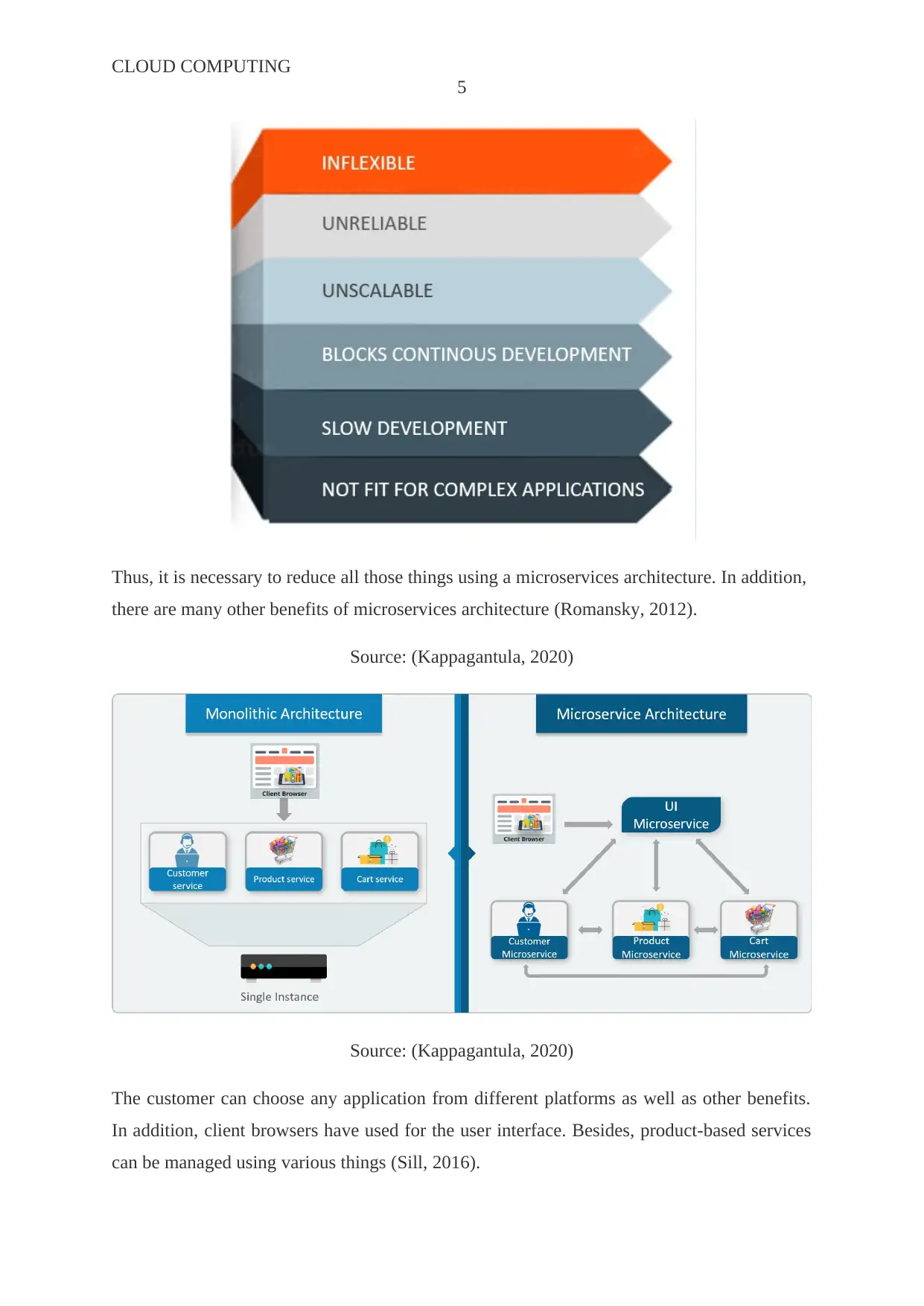
CLOUD COMPUTING
5
Thus, it is necessary to reduce all those things using a microservices architecture. In addition,
there are many other benefits of microservices architecture (Romansky, 2012).
Source: (Kappagantula, 2020)
Source: (Kappagantula, 2020)
The customer can choose any application from different platforms as well as other benefits.
In addition, client browsers have used for the user interface. Besides, product-based services
can be managed using various things (Sill, 2016).
5
Thus, it is necessary to reduce all those things using a microservices architecture. In addition,
there are many other benefits of microservices architecture (Romansky, 2012).
Source: (Kappagantula, 2020)
Source: (Kappagantula, 2020)
The customer can choose any application from different platforms as well as other benefits.
In addition, client browsers have used for the user interface. Besides, product-based services
can be managed using various things (Sill, 2016).
⊘ This is a preview!⊘
Do you want full access?
Subscribe today to unlock all pages.

Trusted by 1+ million students worldwide
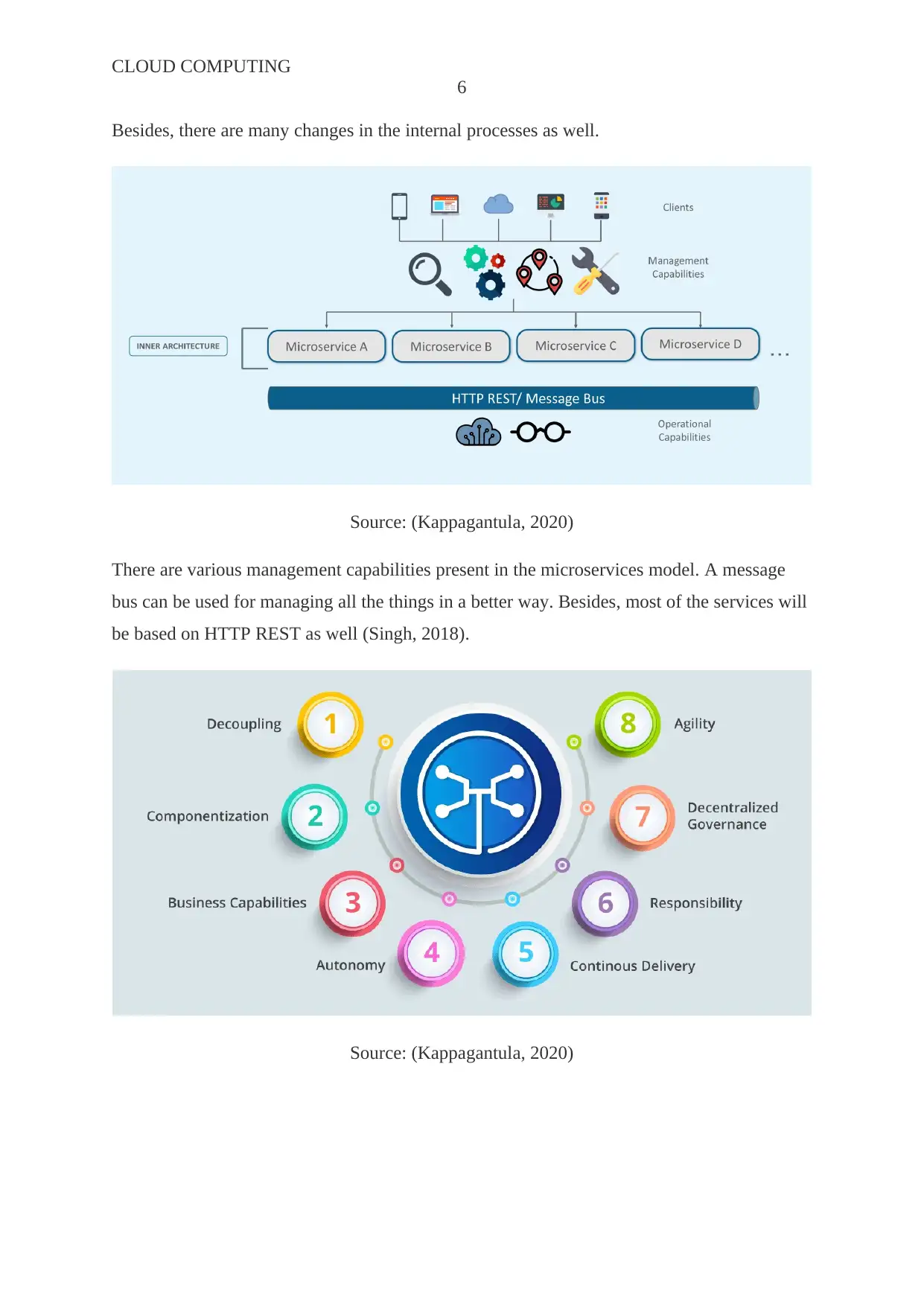
CLOUD COMPUTING
6
Besides, there are many changes in the internal processes as well.
Source: (Kappagantula, 2020)
There are various management capabilities present in the microservices model. A message
bus can be used for managing all the things in a better way. Besides, most of the services will
be based on HTTP REST as well (Singh, 2018).
Source: (Kappagantula, 2020)
6
Besides, there are many changes in the internal processes as well.
Source: (Kappagantula, 2020)
There are various management capabilities present in the microservices model. A message
bus can be used for managing all the things in a better way. Besides, most of the services will
be based on HTTP REST as well (Singh, 2018).
Source: (Kappagantula, 2020)
Paraphrase This Document
Need a fresh take? Get an instant paraphrase of this document with our AI Paraphraser
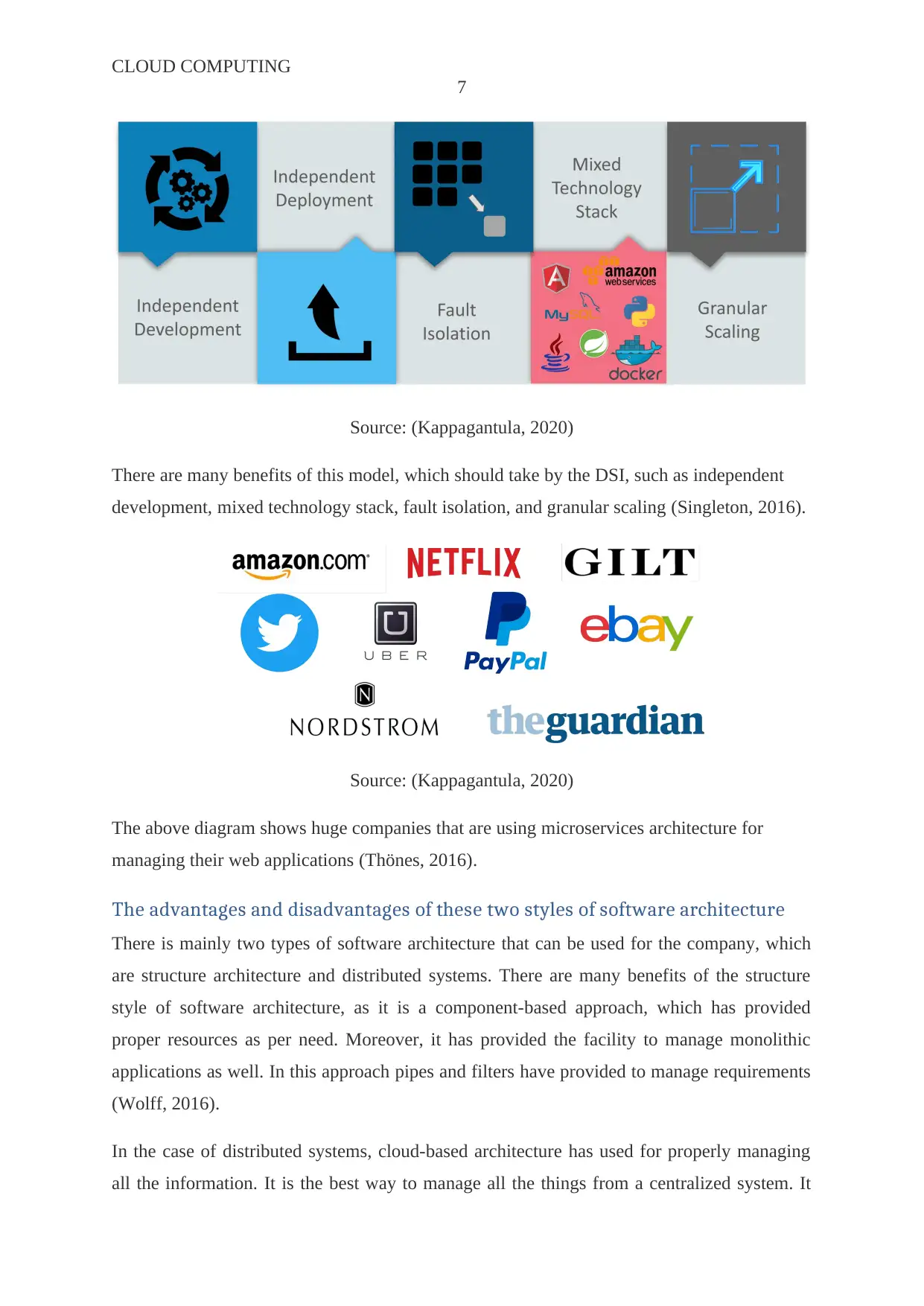
CLOUD COMPUTING
7
Source: (Kappagantula, 2020)
There are many benefits of this model, which should take by the DSI, such as independent
development, mixed technology stack, fault isolation, and granular scaling (Singleton, 2016).
Source: (Kappagantula, 2020)
The above diagram shows huge companies that are using microservices architecture for
managing their web applications (Thönes, 2016).
The advantages and disadvantages of these two styles of software architecture
There is mainly two types of software architecture that can be used for the company, which
are structure architecture and distributed systems. There are many benefits of the structure
style of software architecture, as it is a component-based approach, which has provided
proper resources as per need. Moreover, it has provided the facility to manage monolithic
applications as well. In this approach pipes and filters have provided to manage requirements
(Wolff, 2016).
In the case of distributed systems, cloud-based architecture has used for properly managing
all the information. It is the best way to manage all the things from a centralized system. It
7
Source: (Kappagantula, 2020)
There are many benefits of this model, which should take by the DSI, such as independent
development, mixed technology stack, fault isolation, and granular scaling (Singleton, 2016).
Source: (Kappagantula, 2020)
The above diagram shows huge companies that are using microservices architecture for
managing their web applications (Thönes, 2016).
The advantages and disadvantages of these two styles of software architecture
There is mainly two types of software architecture that can be used for the company, which
are structure architecture and distributed systems. There are many benefits of the structure
style of software architecture, as it is a component-based approach, which has provided
proper resources as per need. Moreover, it has provided the facility to manage monolithic
applications as well. In this approach pipes and filters have provided to manage requirements
(Wolff, 2016).
In the case of distributed systems, cloud-based architecture has used for properly managing
all the information. It is the best way to manage all the things from a centralized system. It
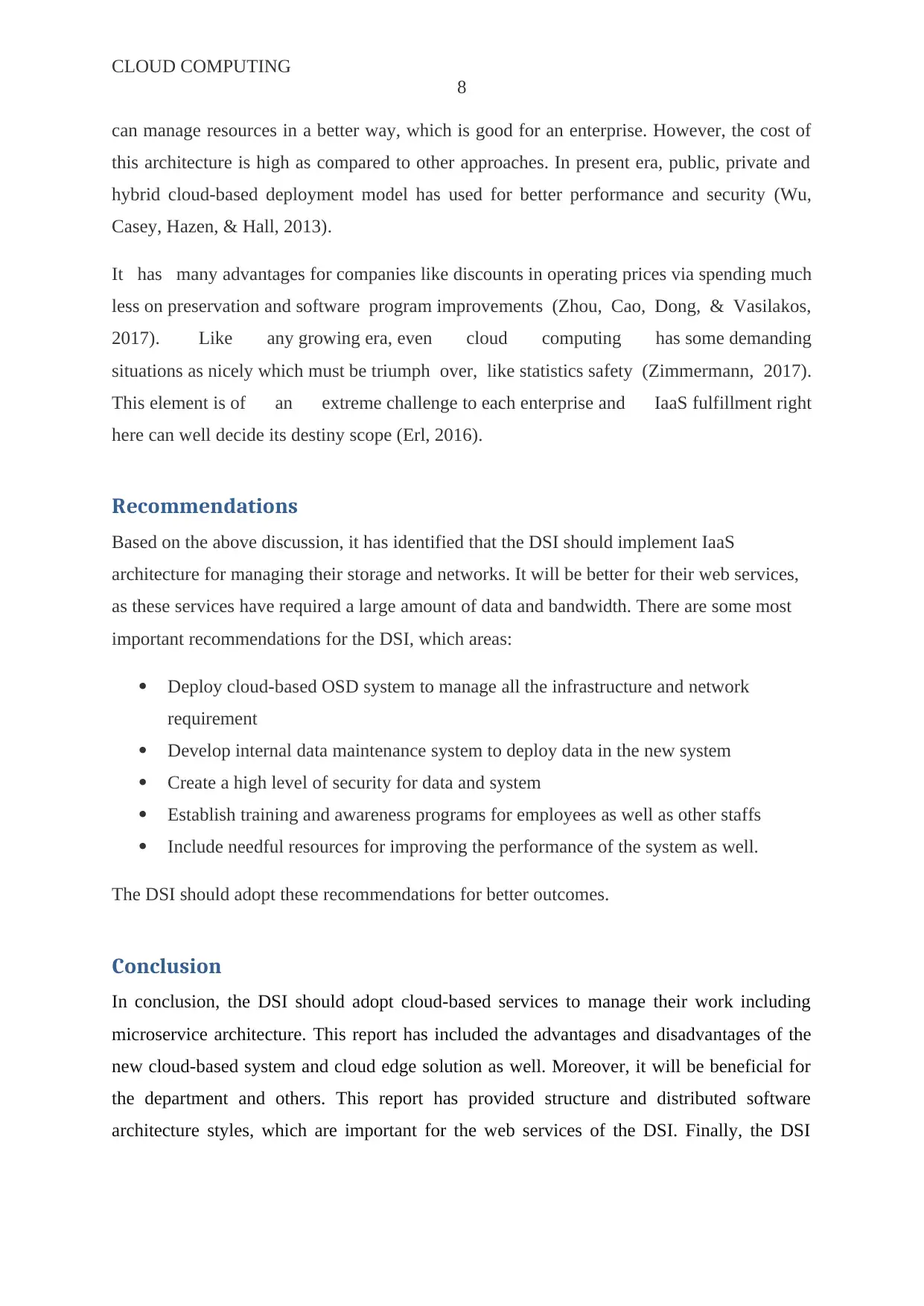
CLOUD COMPUTING
8
can manage resources in a better way, which is good for an enterprise. However, the cost of
this architecture is high as compared to other approaches. In present era, public, private and
hybrid cloud-based deployment model has used for better performance and security (Wu,
Casey, Hazen, & Hall, 2013).
It has many advantages for companies like discounts in operating prices via spending much
less on preservation and software program improvements (Zhou, Cao, Dong, & Vasilakos,
2017). Like any growing era, even cloud computing has some demanding
situations as nicely which must be triumph over, like statistics safety (Zimmermann, 2017).
This element is of an extreme challenge to each enterprise and IaaS fulfillment right
here can well decide its destiny scope (Erl, 2016).
Recommendations
Based on the above discussion, it has identified that the DSI should implement IaaS
architecture for managing their storage and networks. It will be better for their web services,
as these services have required a large amount of data and bandwidth. There are some most
important recommendations for the DSI, which areas:
Deploy cloud-based OSD system to manage all the infrastructure and network
requirement
Develop internal data maintenance system to deploy data in the new system
Create a high level of security for data and system
Establish training and awareness programs for employees as well as other staffs
Include needful resources for improving the performance of the system as well.
The DSI should adopt these recommendations for better outcomes.
Conclusion
In conclusion, the DSI should adopt cloud-based services to manage their work including
microservice architecture. This report has included the advantages and disadvantages of the
new cloud-based system and cloud edge solution as well. Moreover, it will be beneficial for
the department and others. This report has provided structure and distributed software
architecture styles, which are important for the web services of the DSI. Finally, the DSI
8
can manage resources in a better way, which is good for an enterprise. However, the cost of
this architecture is high as compared to other approaches. In present era, public, private and
hybrid cloud-based deployment model has used for better performance and security (Wu,
Casey, Hazen, & Hall, 2013).
It has many advantages for companies like discounts in operating prices via spending much
less on preservation and software program improvements (Zhou, Cao, Dong, & Vasilakos,
2017). Like any growing era, even cloud computing has some demanding
situations as nicely which must be triumph over, like statistics safety (Zimmermann, 2017).
This element is of an extreme challenge to each enterprise and IaaS fulfillment right
here can well decide its destiny scope (Erl, 2016).
Recommendations
Based on the above discussion, it has identified that the DSI should implement IaaS
architecture for managing their storage and networks. It will be better for their web services,
as these services have required a large amount of data and bandwidth. There are some most
important recommendations for the DSI, which areas:
Deploy cloud-based OSD system to manage all the infrastructure and network
requirement
Develop internal data maintenance system to deploy data in the new system
Create a high level of security for data and system
Establish training and awareness programs for employees as well as other staffs
Include needful resources for improving the performance of the system as well.
The DSI should adopt these recommendations for better outcomes.
Conclusion
In conclusion, the DSI should adopt cloud-based services to manage their work including
microservice architecture. This report has included the advantages and disadvantages of the
new cloud-based system and cloud edge solution as well. Moreover, it will be beneficial for
the department and others. This report has provided structure and distributed software
architecture styles, which are important for the web services of the DSI. Finally, the DSI
⊘ This is a preview!⊘
Do you want full access?
Subscribe today to unlock all pages.

Trusted by 1+ million students worldwide

CLOUD COMPUTING
9
should implement and deploy a new project on the microservice architecture, which will be
beneficial for other departments as well.
9
should implement and deploy a new project on the microservice architecture, which will be
beneficial for other departments as well.
Paraphrase This Document
Need a fresh take? Get an instant paraphrase of this document with our AI Paraphraser
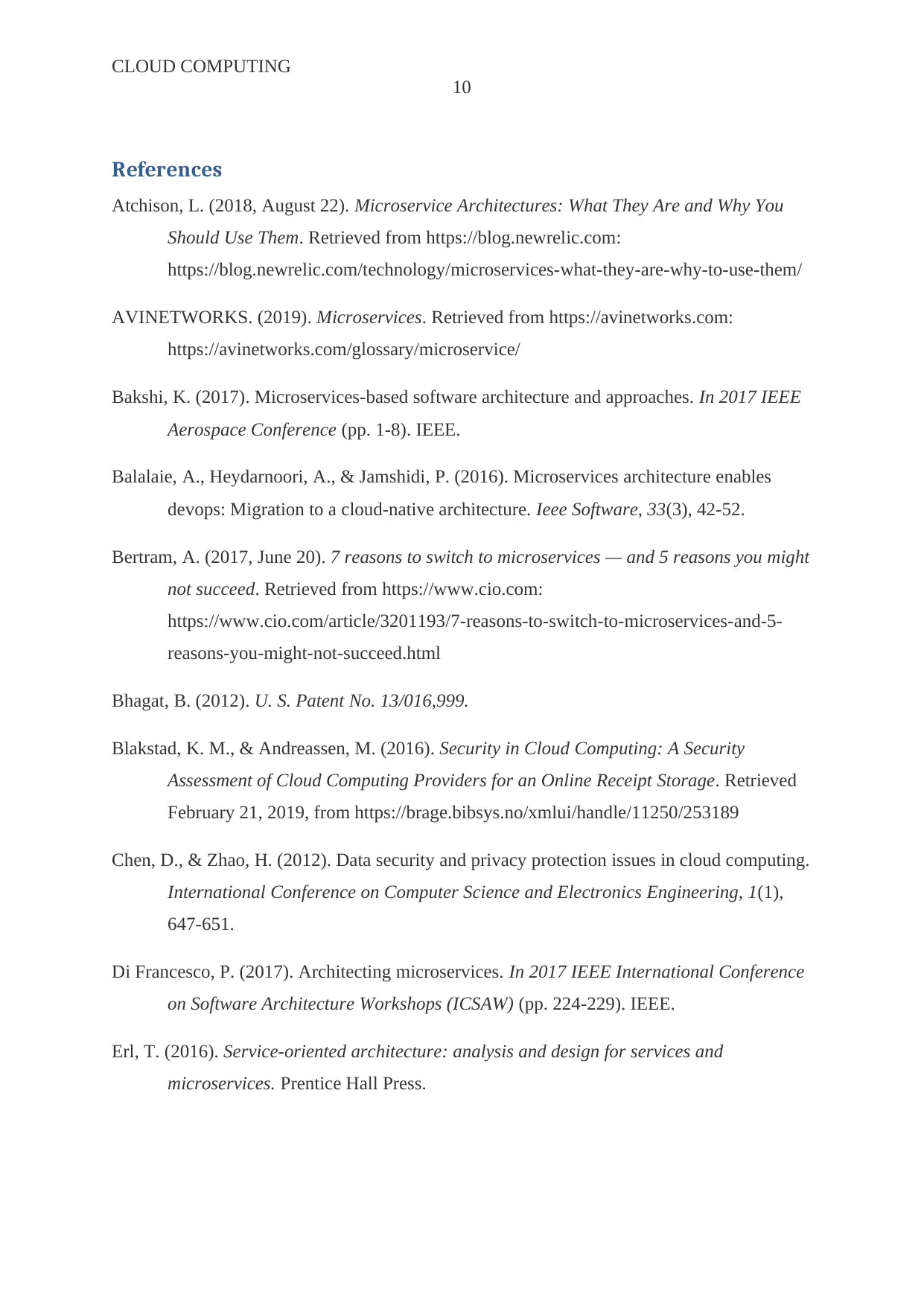
CLOUD COMPUTING
10
References
Atchison, L. (2018, August 22). Microservice Architectures: What They Are and Why You
Should Use Them. Retrieved from https://blog.newrelic.com:
https://blog.newrelic.com/technology/microservices-what-they-are-why-to-use-them/
AVINETWORKS. (2019). Microservices. Retrieved from https://avinetworks.com:
https://avinetworks.com/glossary/microservice/
Bakshi, K. (2017). Microservices-based software architecture and approaches. In 2017 IEEE
Aerospace Conference (pp. 1-8). IEEE.
Balalaie, A., Heydarnoori, A., & Jamshidi, P. (2016). Microservices architecture enables
devops: Migration to a cloud-native architecture. Ieee Software, 33(3), 42-52.
Bertram, A. (2017, June 20). 7 reasons to switch to microservices — and 5 reasons you might
not succeed. Retrieved from https://www.cio.com:
https://www.cio.com/article/3201193/7-reasons-to-switch-to-microservices-and-5-
reasons-you-might-not-succeed.html
Bhagat, B. (2012). U. S. Patent No. 13/016,999.
Blakstad, K. M., & Andreassen, M. (2016). Security in Cloud Computing: A Security
Assessment of Cloud Computing Providers for an Online Receipt Storage. Retrieved
February 21, 2019, from https://brage.bibsys.no/xmlui/handle/11250/253189
Chen, D., & Zhao, H. (2012). Data security and privacy protection issues in cloud computing.
International Conference on Computer Science and Electronics Engineering, 1(1),
647-651.
Di Francesco, P. (2017). Architecting microservices. In 2017 IEEE International Conference
on Software Architecture Workshops (ICSAW) (pp. 224-229). IEEE.
Erl, T. (2016). Service-oriented architecture: analysis and design for services and
microservices. Prentice Hall Press.
10
References
Atchison, L. (2018, August 22). Microservice Architectures: What They Are and Why You
Should Use Them. Retrieved from https://blog.newrelic.com:
https://blog.newrelic.com/technology/microservices-what-they-are-why-to-use-them/
AVINETWORKS. (2019). Microservices. Retrieved from https://avinetworks.com:
https://avinetworks.com/glossary/microservice/
Bakshi, K. (2017). Microservices-based software architecture and approaches. In 2017 IEEE
Aerospace Conference (pp. 1-8). IEEE.
Balalaie, A., Heydarnoori, A., & Jamshidi, P. (2016). Microservices architecture enables
devops: Migration to a cloud-native architecture. Ieee Software, 33(3), 42-52.
Bertram, A. (2017, June 20). 7 reasons to switch to microservices — and 5 reasons you might
not succeed. Retrieved from https://www.cio.com:
https://www.cio.com/article/3201193/7-reasons-to-switch-to-microservices-and-5-
reasons-you-might-not-succeed.html
Bhagat, B. (2012). U. S. Patent No. 13/016,999.
Blakstad, K. M., & Andreassen, M. (2016). Security in Cloud Computing: A Security
Assessment of Cloud Computing Providers for an Online Receipt Storage. Retrieved
February 21, 2019, from https://brage.bibsys.no/xmlui/handle/11250/253189
Chen, D., & Zhao, H. (2012). Data security and privacy protection issues in cloud computing.
International Conference on Computer Science and Electronics Engineering, 1(1),
647-651.
Di Francesco, P. (2017). Architecting microservices. In 2017 IEEE International Conference
on Software Architecture Workshops (ICSAW) (pp. 224-229). IEEE.
Erl, T. (2016). Service-oriented architecture: analysis and design for services and
microservices. Prentice Hall Press.
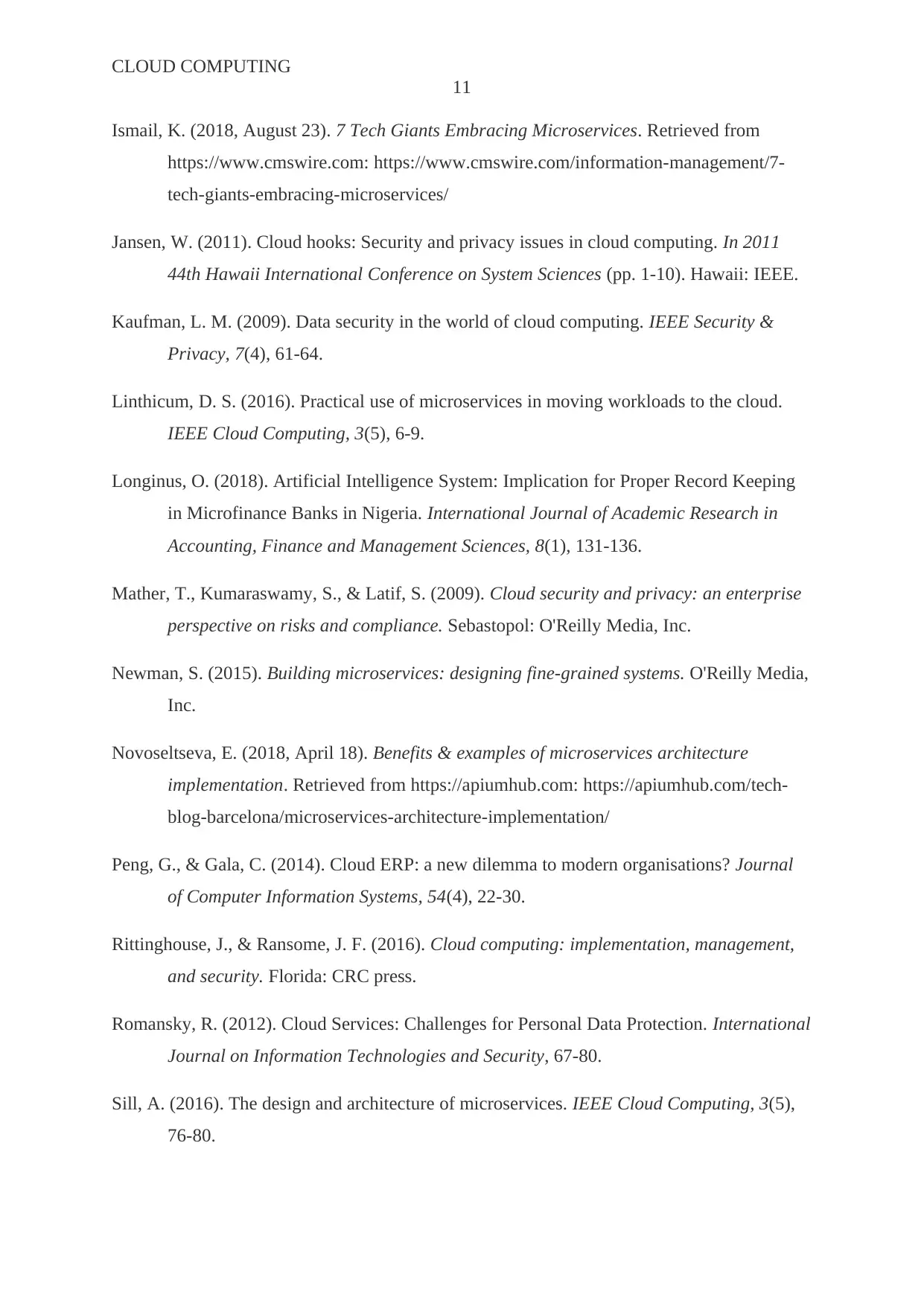
CLOUD COMPUTING
11
Ismail, K. (2018, August 23). 7 Tech Giants Embracing Microservices. Retrieved from
https://www.cmswire.com: https://www.cmswire.com/information-management/7-
tech-giants-embracing-microservices/
Jansen, W. (2011). Cloud hooks: Security and privacy issues in cloud computing. In 2011
44th Hawaii International Conference on System Sciences (pp. 1-10). Hawaii: IEEE.
Kaufman, L. M. (2009). Data security in the world of cloud computing. IEEE Security &
Privacy, 7(4), 61-64.
Linthicum, D. S. (2016). Practical use of microservices in moving workloads to the cloud.
IEEE Cloud Computing, 3(5), 6-9.
Longinus, O. (2018). Artificial Intelligence System: Implication for Proper Record Keeping
in Microfinance Banks in Nigeria. International Journal of Academic Research in
Accounting, Finance and Management Sciences, 8(1), 131-136.
Mather, T., Kumaraswamy, S., & Latif, S. (2009). Cloud security and privacy: an enterprise
perspective on risks and compliance. Sebastopol: O'Reilly Media, Inc.
Newman, S. (2015). Building microservices: designing fine-grained systems. O'Reilly Media,
Inc.
Novoseltseva, E. (2018, April 18). Benefits & examples of microservices architecture
implementation. Retrieved from https://apiumhub.com: https://apiumhub.com/tech-
blog-barcelona/microservices-architecture-implementation/
Peng, G., & Gala, C. (2014). Cloud ERP: a new dilemma to modern organisations? Journal
of Computer Information Systems, 54(4), 22-30.
Rittinghouse, J., & Ransome, J. F. (2016). Cloud computing: implementation, management,
and security. Florida: CRC press.
Romansky, R. (2012). Cloud Services: Challenges for Personal Data Protection. International
Journal on Information Technologies and Security, 67-80.
Sill, A. (2016). The design and architecture of microservices. IEEE Cloud Computing, 3(5),
76-80.
11
Ismail, K. (2018, August 23). 7 Tech Giants Embracing Microservices. Retrieved from
https://www.cmswire.com: https://www.cmswire.com/information-management/7-
tech-giants-embracing-microservices/
Jansen, W. (2011). Cloud hooks: Security and privacy issues in cloud computing. In 2011
44th Hawaii International Conference on System Sciences (pp. 1-10). Hawaii: IEEE.
Kaufman, L. M. (2009). Data security in the world of cloud computing. IEEE Security &
Privacy, 7(4), 61-64.
Linthicum, D. S. (2016). Practical use of microservices in moving workloads to the cloud.
IEEE Cloud Computing, 3(5), 6-9.
Longinus, O. (2018). Artificial Intelligence System: Implication for Proper Record Keeping
in Microfinance Banks in Nigeria. International Journal of Academic Research in
Accounting, Finance and Management Sciences, 8(1), 131-136.
Mather, T., Kumaraswamy, S., & Latif, S. (2009). Cloud security and privacy: an enterprise
perspective on risks and compliance. Sebastopol: O'Reilly Media, Inc.
Newman, S. (2015). Building microservices: designing fine-grained systems. O'Reilly Media,
Inc.
Novoseltseva, E. (2018, April 18). Benefits & examples of microservices architecture
implementation. Retrieved from https://apiumhub.com: https://apiumhub.com/tech-
blog-barcelona/microservices-architecture-implementation/
Peng, G., & Gala, C. (2014). Cloud ERP: a new dilemma to modern organisations? Journal
of Computer Information Systems, 54(4), 22-30.
Rittinghouse, J., & Ransome, J. F. (2016). Cloud computing: implementation, management,
and security. Florida: CRC press.
Romansky, R. (2012). Cloud Services: Challenges for Personal Data Protection. International
Journal on Information Technologies and Security, 67-80.
Sill, A. (2016). The design and architecture of microservices. IEEE Cloud Computing, 3(5),
76-80.
⊘ This is a preview!⊘
Do you want full access?
Subscribe today to unlock all pages.

Trusted by 1+ million students worldwide
1 out of 13
Related Documents
Your All-in-One AI-Powered Toolkit for Academic Success.
+13062052269
info@desklib.com
Available 24*7 on WhatsApp / Email
![[object Object]](/_next/static/media/star-bottom.7253800d.svg)
Unlock your academic potential
Copyright © 2020–2025 A2Z Services. All Rights Reserved. Developed and managed by ZUCOL.





